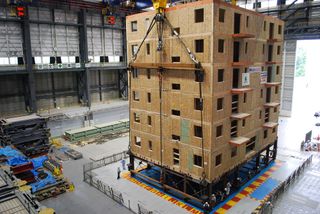Creating an Indoor Earthquake

On July 14th, this six-story, woodframe condominium building — shown here still under construction — will be shaken with earthquake forces that occur, on average, only once every 2,500 years.
The final experiment of the multi-year NEESWood project, the effort will test new ways to construct buildings that can withstand the severe forces of nature. The N-E-E-S in NEESWood stands for the Network for Earthquake Engineering Simulation, a network of National Science Foundation earthquake simulation facilities.
At 11:00 AM EDT on that date, the National Science Foundation will hold a live webcast featuring footage from the shake and an opportunity for the public to ask questions of the engineers behind the project.
Woodframe construction can be more affordable for mid-rise buildings than other methods, but little is known about how such buildings respond to earthquakes. NEESWood set out in 2005 to study how woodframe structures built to current specifications respond to the shaking of earthquakes and to use resulting data to develop models engineers could use to design safer buildings.
NEESWood's first test was carried out at a shake-table facility at the University at Buffalo one of the National Science Foundation's 15 NEES laboratories.
The test subjected a fully constructed home to an accurate simulation of the 1994 Northridge earthquake, including an earthquake 50 percent more intense than those engineers currently design buildings to withstand.
From the test, the NEESWood engineers learned that woodframe houses can provide survivable environments during an earthquake, but damage is so severe that extensive repairs are required if the building is to remain in use.
Sign up for the Live Science daily newsletter now
Get the world’s most fascinating discoveries delivered straight to your inbox.
For the final, Capstone, test on July 14 2009, (and several smaller tests beginning on June 30), engineers hope to learn how larger buildings, such as mid-rise condominiums, would fare under the same conditions.
The same shaking motions from the Northridge quake will be behind the latest test, but they will be amplified for the final experiment to a level that equates to the strength of an earthquake that only happens every 2,500 years.
In the image above, an enormous transport mechanism has just emplaced the NEESWood capstone structure onto the world’s largest shake table, part of E-Defense, a facility of the Japanese government’s National Research Institute for Earth Science and Disaster prevention, located in the city of Miki, north of Kobe, Japan.
E-Defense has a partnership with the NEES facilities to conduct research that will aid engineers in both Japan and the United States as they strive to design more resilient structures. The partnership extends from a memorandum of understanding that the National Science Foundation signed with Japan’s Ministry of Education, Culture, Sports, Science and Technology.
Note:The test mentioned in this article was performed on July 9, 2009. See the video below.
Editor's Note: Any opinions, findings, and conclusions or recommendations expressed in this material are those of the author and do not necessarily reflect the views of the National Science Foundation. See the Research in Action archive.

